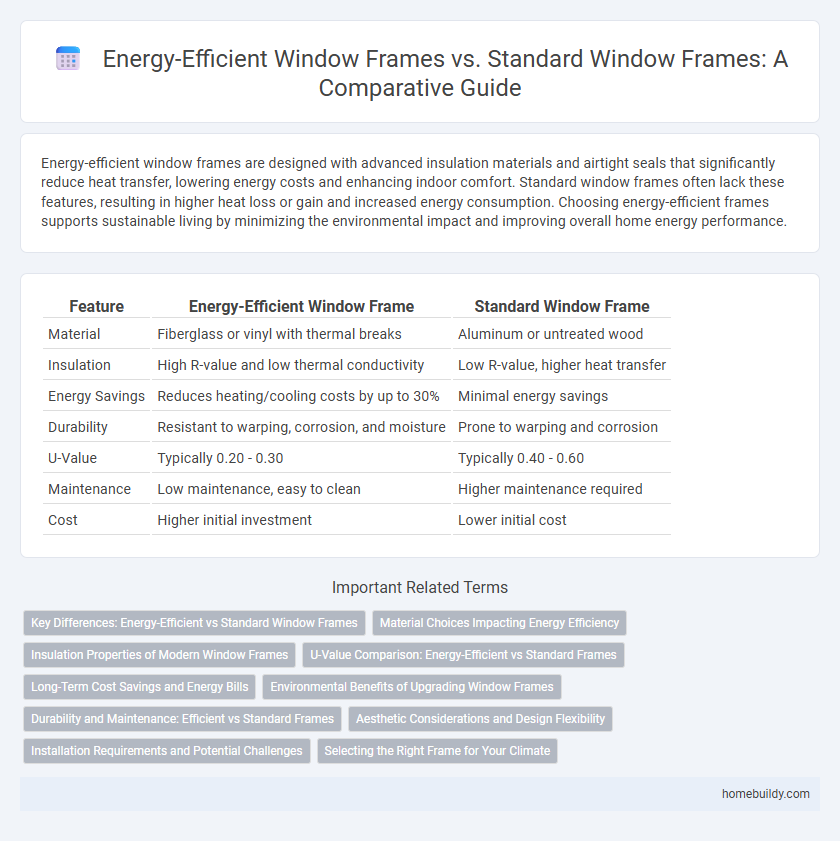Energy-efficient window frames are designed with advanced insulation materials and airtight seals that significantly reduce heat transfer, lowering energy costs and enhancing indoor comfort. Standard window frames often lack these features, resulting in higher heat loss or gain and increased energy consumption. Choosing energy-efficient frames supports sustainable living by minimizing the environmental impact and improving overall home energy performance.
Table of Comparison
| Feature | Energy-Efficient Window Frame | Standard Window Frame |
|---|---|---|
| Material | Fiberglass or vinyl with thermal breaks | Aluminum or untreated wood |
| Insulation | High R-value and low thermal conductivity | Low R-value, higher heat transfer |
| Energy Savings | Reduces heating/cooling costs by up to 30% | Minimal energy savings |
| Durability | Resistant to warping, corrosion, and moisture | Prone to warping and corrosion |
| U-Value | Typically 0.20 - 0.30 | Typically 0.40 - 0.60 |
| Maintenance | Low maintenance, easy to clean | Higher maintenance required |
| Cost | Higher initial investment | Lower initial cost |
Key Differences: Energy-Efficient vs Standard Window Frames
Energy-efficient window frames are designed with advanced materials such as fiberglass or vinyl combined with thermal breaks to significantly reduce heat transfer, enhancing insulation compared to standard frames typically made from aluminum or wood without these features. These frames often incorporate multi-chambered profiles and low-conductivity spacers, which improve energy performance and reduce heating and cooling costs. Standard window frames generally lack these specialized technologies, resulting in higher thermal conductivity and less effective temperature regulation.
Material Choices Impacting Energy Efficiency
Energy-efficient window frames primarily utilize materials such as fiberglass, vinyl, and wood composites, each offering superior insulation properties compared to standard aluminum frames known for high thermal conductivity. Fiberglass frames provide excellent thermal performance by minimizing heat transfer, while vinyl frames are cost-effective and resistant to moisture, reducing energy loss. Wood composite frames combine natural insulating benefits with durability, enhancing overall energy savings by maintaining stable indoor temperatures.
Insulation Properties of Modern Window Frames
Modern energy-efficient window frames significantly improve insulation properties compared to standard window frames through advanced materials like fiberglass, vinyl, and composite blends. These frames reduce thermal conductivity, minimizing heat loss in winter and heat gain in summer, which enhances overall energy performance and lowers utility bills. Enhanced sealing technology and multi-chamber designs further prevent air infiltration, contributing to superior thermal insulation and increased comfort within the home.
U-Value Comparison: Energy-Efficient vs Standard Frames
Energy-efficient window frames typically have a U-value ranging from 0.20 to 0.35 BTU/hr*ft2*degF, significantly lower than standard frames, which average around 0.50 to 1.20 BTU/hr*ft2*degF. This lower U-value indicates superior insulation performance, reducing heat transfer and improving thermal efficiency in buildings. Choosing energy-efficient frames contributes to substantial energy savings and enhances indoor comfort by maintaining consistent temperatures.
Long-Term Cost Savings and Energy Bills
Energy-efficient window frames significantly reduce heat transfer through advanced materials like vinyl, fiberglass, or wood composites, leading to lower energy consumption for heating and cooling. Over time, these frames decrease monthly energy bills by improving insulation and minimizing air leakage, contributing to substantial long-term cost savings. Compared to standard window frames, which often have higher thermal conductivity, energy-efficient options provide a better return on investment through ongoing household utility savings.
Environmental Benefits of Upgrading Window Frames
Energy-efficient window frames significantly reduce heat transfer, lowering heating and cooling demands and thus decreasing overall energy consumption. These frames utilize advanced materials like thermally broken aluminum or insulated vinyl, which enhance insulation and minimize thermal bridging. Upgrading to energy-efficient frames contributes to reduced greenhouse gas emissions and a smaller carbon footprint, supporting sustainable building practices and long-term environmental preservation.
Durability and Maintenance: Efficient vs Standard Frames
Energy-efficient window frames typically feature advanced materials like vinyl, fiberglass, or composite, which offer superior durability and resistance to warping, cracking, and corrosion compared to standard wood or aluminum frames. These efficient frames often require minimal maintenance, reducing the need for frequent painting, sealing, or repairs that standard frames commonly demand. Long-lasting seals and multi-chambered designs in energy-efficient frames contribute to sustained performance and lower upkeep costs over time.
Aesthetic Considerations and Design Flexibility
Energy-efficient window frames often utilize advanced materials like fiberglass or vinyl, offering sleek profiles and a variety of color options that enhance modern architectural aesthetics. These frames provide greater design flexibility with customizable shapes and finishes, allowing seamless integration into diverse building styles. In contrast, standard window frames typically use aluminum or wood, which may limit design choices and lack the refined appearance of energy-efficient alternatives.
Installation Requirements and Potential Challenges
Energy-efficient window frames often demand precise installation techniques to maximize thermal performance, including airtight sealing and proper insulation around the frame, which can complicate fitting compared to standard window frames. Standard frames generally have more straightforward installation processes with fewer specialized materials, but they may lead to increased air leakage and energy loss over time. Potential challenges with energy-efficient frames include higher upfront labor costs and the need for skilled installers to avoid compromising the frame's insulating properties.
Selecting the Right Frame for Your Climate
Choosing the right window frame for your climate significantly impacts energy efficiency, with materials like vinyl and fiberglass offering superior insulation compared to standard aluminum frames. Energy-efficient window frames reduce heat transfer by incorporating thermal breaks and multi-chambered designs, which are crucial in extreme weather conditions. Selecting frames tailored to local climate zones enhances indoor comfort and lowers heating and cooling costs over time.
energy-efficient window frame vs standard window frame Infographic

 homebuildy.com
homebuildy.com